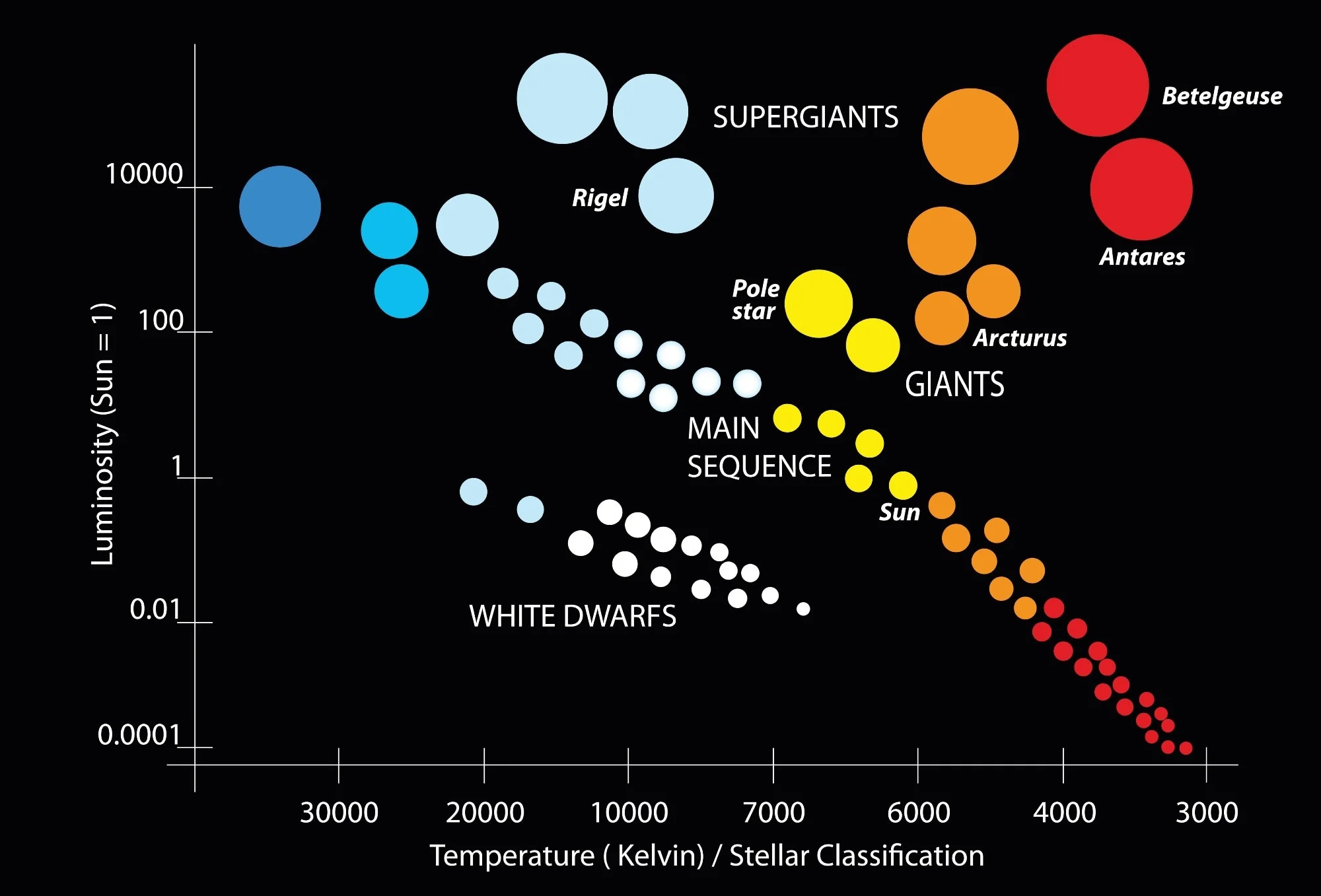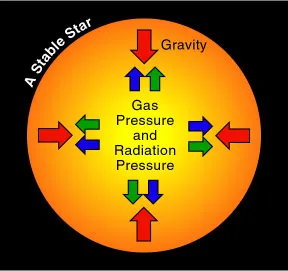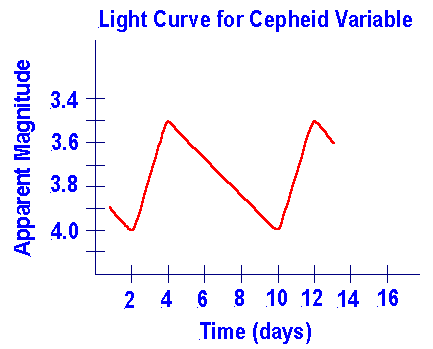option D: astrophysics
1/36
Earn XP
Description and Tags
Name | Mastery | Learn | Test | Matching | Spaced | Call with Kai |
|---|
No study sessions yet.
37 Terms
making degrees more smaller
1º = 60’ (minutes of arc)
1’ = 60’’ (seconds of arc)
1º = 3600’’
parallax
the apparent shift of a near star compared to the distant stars over a period of time
a star will look like it has moved backwards and forwards throughout the year
really it is Earth that has moved which changes the perspective from which we look
other stars will look like they haven’t moved because they are so far away
angle of parallax and finding it
angle of parallax is measured in seconds of arc, is it is 1’ the distance is one parsec
further away = smaller angle of parallax
distance between earth’s position in June and in December is 2R, p = parallax angle
the distance to the star is Tanp = R/d therefore d=R/tanp
using small angle approximation:
tanp = p therefore d=R/p (when the angle is measured in radians)
finding distance in parsecs
when these distances are too approximate
d(parsec) = 1/p (arc-second)
angles smaller the 1/100 arc seconds are too small to measure accurately so distances farther away than about 100 parsecs are too approximate to be useful
luminosity
stars are assumed to radiate like black bodies (emissivity =1), equation is P=eσAT^4
luminosity = power of a star
L=σAT^4
power
efficiency
σ — constant
area — can be written as area of a circle (stars are spheres but we see circles)
L=σπR^2T^4
temperature
combining brightness and luminosity equations
surface are of a sphere = 4πR^2
brightness is the power per unit area received at a distance from the source
b=L/4πR^2
luminosity cannot be directly measured but it can be calculated from brightness and distance found using parallax
combining the two formulae (not in data booklet)
b=σAT^4/4πd^2
d = distance from us to star
stellar spectra and Wien’s law
stellar spectra — below 400nm = ultraviolet radiation at a hotter temperature
Wien’s law — λmaxT = 2.9x10^-3 mK
because the product is a constant λ and T are inversely proportional
the smaller the maximum wavelength, the greater the temperature
classifying stars based on temperature
stars are separated into classes based on their temperature
hot to cold = O, B, A, F, G, K, M
our sun is class G
the hottest stars are blue and the coldest are red
Hertzsprung-Russell (HR) diagram
stars age following the main sequence from top left to bottom right
temperature is measured from highest to lowest — pay attention to the axes
L star/L☉ is used for the y axis, ☉ represents the sun, ratio of Lstar to L☉
y axis is exponential

brightness and luminosity of the super giants, relative to the sun
why there aren’t super giants in the bottom left of the HR diagram
super giants have to be incredibly big to be brighter than the sun given the equations for brightness and luminosity
no super giants in the bottom left corner because the temperature is too high (relative to the luminosity), we don’t see objects of that temperature in the universe
linking luminosity and mass for main sequence stars
for stars in the main sequence the luminosity and mass (M) of the star can be linked
L=σAT^4
A=4πR^2
L∝R^2
L∝M^3.5
3.5 comes from the exponent for the main sequence gradient
the gradient is not negative because the x axis goes from high to low
impact of a difference in mass on luminosity
a slight difference in the mass causes a huge difference in luminosity
a star with a mass 10 times that of the sun will have a luminosity of 10^3.5 times the luminosity of the sun which is about 3200
stars have different densities
more luminous stars on the main sequence have greater mass and shorter lives than less luminous stars on the main sequence
single star
A luminous sphere of plasma held together by its own gravity.
binary star
two stars orbiting a common centre
black hole
A singularity in space-time.
cepheid variable
A star with a period of varying luminosity. The luminosity can be determined from the period and along with the apparent brightness can be used to determine the distance of the star from Earth.
cluster of galaxies
Two or more galaxies that are close enough to each other to affect each other through gravitation.
constellation
A pattern of stars visible from Earth that are not gravitationally bounded.
dark matter
Matter in galaxies that are too cold to radiate. Its existence is inferred from theoretical physics rather than direct visual contact.
galaxies
stars, gas, and dust held together by gravitational forces.
main sequence star
A normal star that is undergoing nuclear fusion of hydrogen into helium.
neutron stars
A very dense star, consisting only of uncharged neutrons
nebula
A cloud of dust, hydrogen, helium and other ionized gases.
planet
A celestial body that orbits a star.
planetary system
Gravitationally bounded non-stellar objects in orbit around a star or star system.
planetary nebula
The ejected envelope of a red giant star.
stellar clusters
A group of stars gravitationally bounded together.
the stability of a star
depends on the equilibrium of opposing forces
forces = gravitational, gas and radiation pressure
equilibrium gained through nuclear fusion which keeps the star hot

cepheid variables graphed
apparent magnitude of luminosity vs time

stellar evolution for less than 1.4 solar masses (solar mass of the sun = 1)
star stops fusing at about oxygen as the amount of energy released decreases
planetary nebula occurs (big explosion)
outer layers of the star blow away (gravity does not keep them together)
the core (leftover) becomes colder and colder, it contracts more and more (gravity)
electrons behave as a gas in the core and the pressure they generate stops the core from contracting… more from the slide
Chandrasekhar limit
The largest mass a white dwarf can have is about 1.4 solar masses.
electron degeneracy prevents further collapse of the core provided that its mass is less than about 1.4 solar masses
the star will become a stable white dwarf then a black dwarf
dwarf = no fusion = dead star
Oppenheimer-Volkoff limit
the largest mass a neutron star can have is approximately 2-3 solar masses
when the mass of the star is 1.4-2.5 solar masses it is a neutron star
the core will collapse further (due to weight) until electrons are driven into protons forming neutrons
neutron pressure prevents the star from collapsing further which makes it a neutron star
neutron stars are heavy because there is no electromagnetic repulsion
when the Oppenheimer-Volkoff limit is exceeded the star becomes a black hole
Hubble’s law
describes the speed at which celestial bodies move away from each other at the present time and changes because the expansion of the universe if accelerating.
v=Hd
v = velocity
H = Hubble parameter
d = distance
using Hubble’s law to find the age of the universe
using the relationship between speed, distance and time
the age of the universe is the inverse of the Hubble constant

the cosmic scale factor (R)
a function of time which represents the relative expansion of the universe.
This may be represented by
![]()
where d(t) is the proper distance at time t, d0 is the distance at time t0, and a(t) is the cosmic scale factor.
Astrophysicists would out the cosmic scale factor using Einstein’s theory of general relativity laws.
Doppler effect in galaxies
light has a longer wavelength than when it was originally emitted
red shift (z) = unitless measure of the speed of an object as a proportion of the speed of light
change in wavelength due to velocity
galaxies rotate so light is doppler shifted
the radiation from the side approaching the earth is blue shifted and the radiation moving away from the earth is red shifted
velocity of recession
Hubble constant
velocity of recession = Hubble constant x distance
Hubble constant has units of k ms^-1 Mpc^-1
V=H₀d
z=H₀d/c
d=cz/H₀